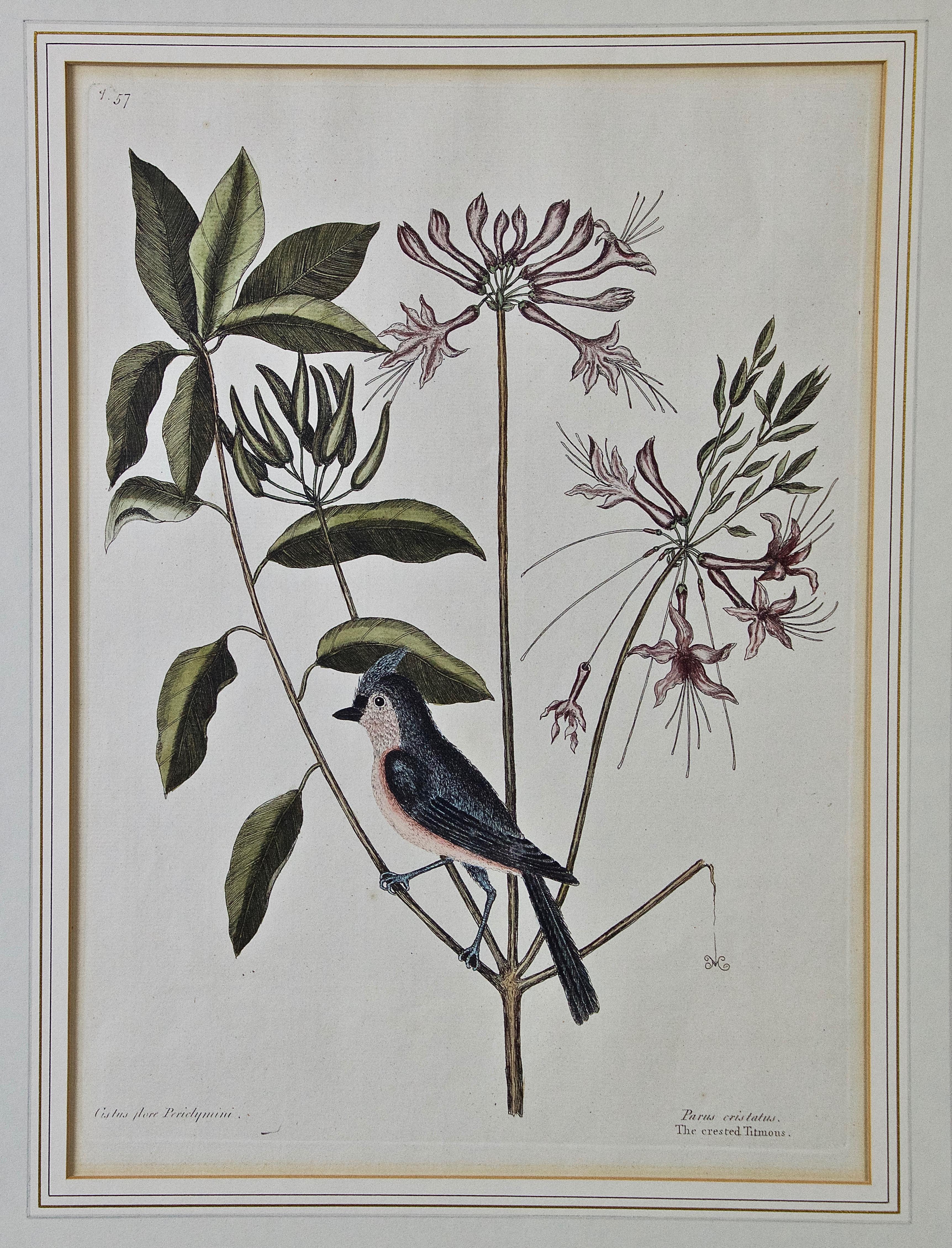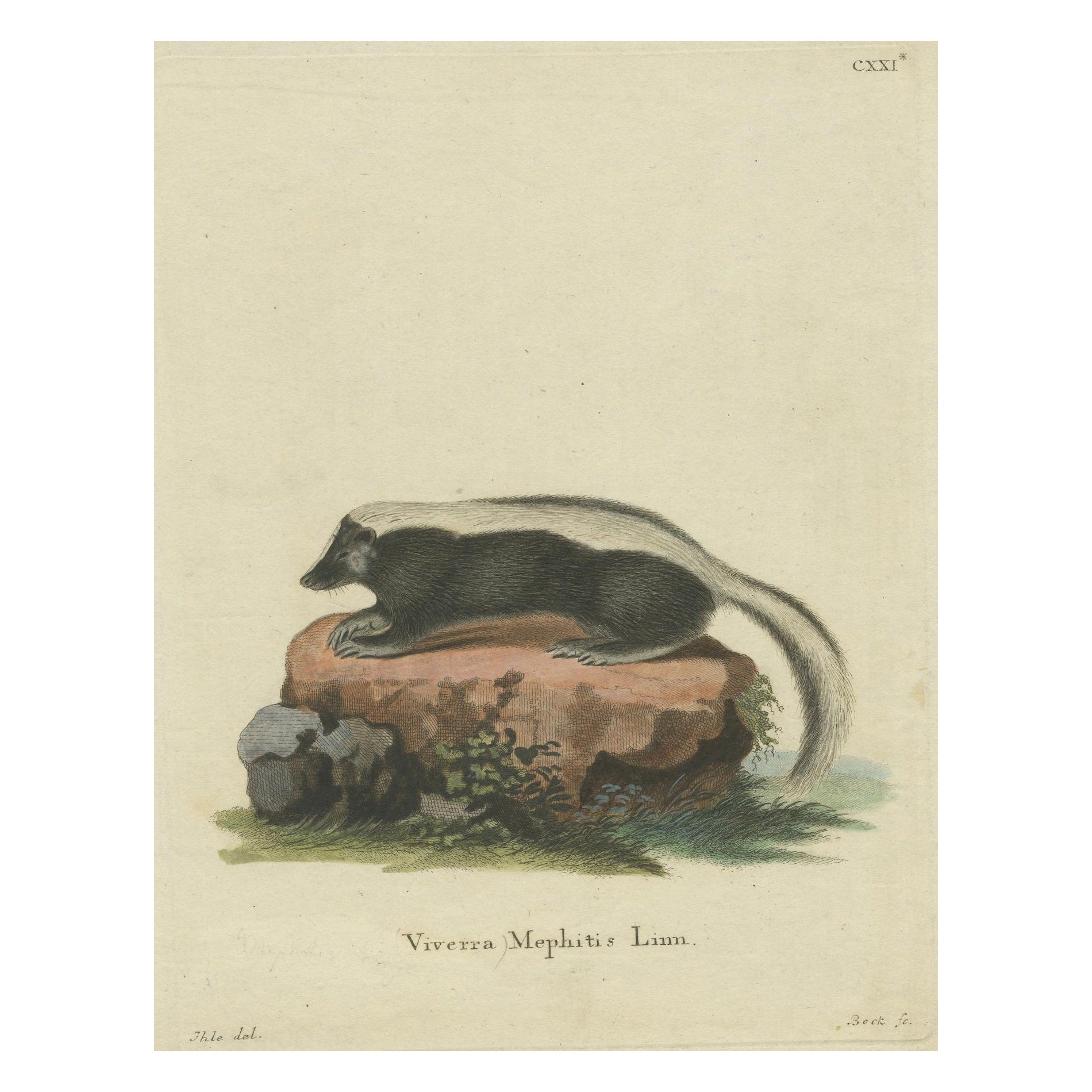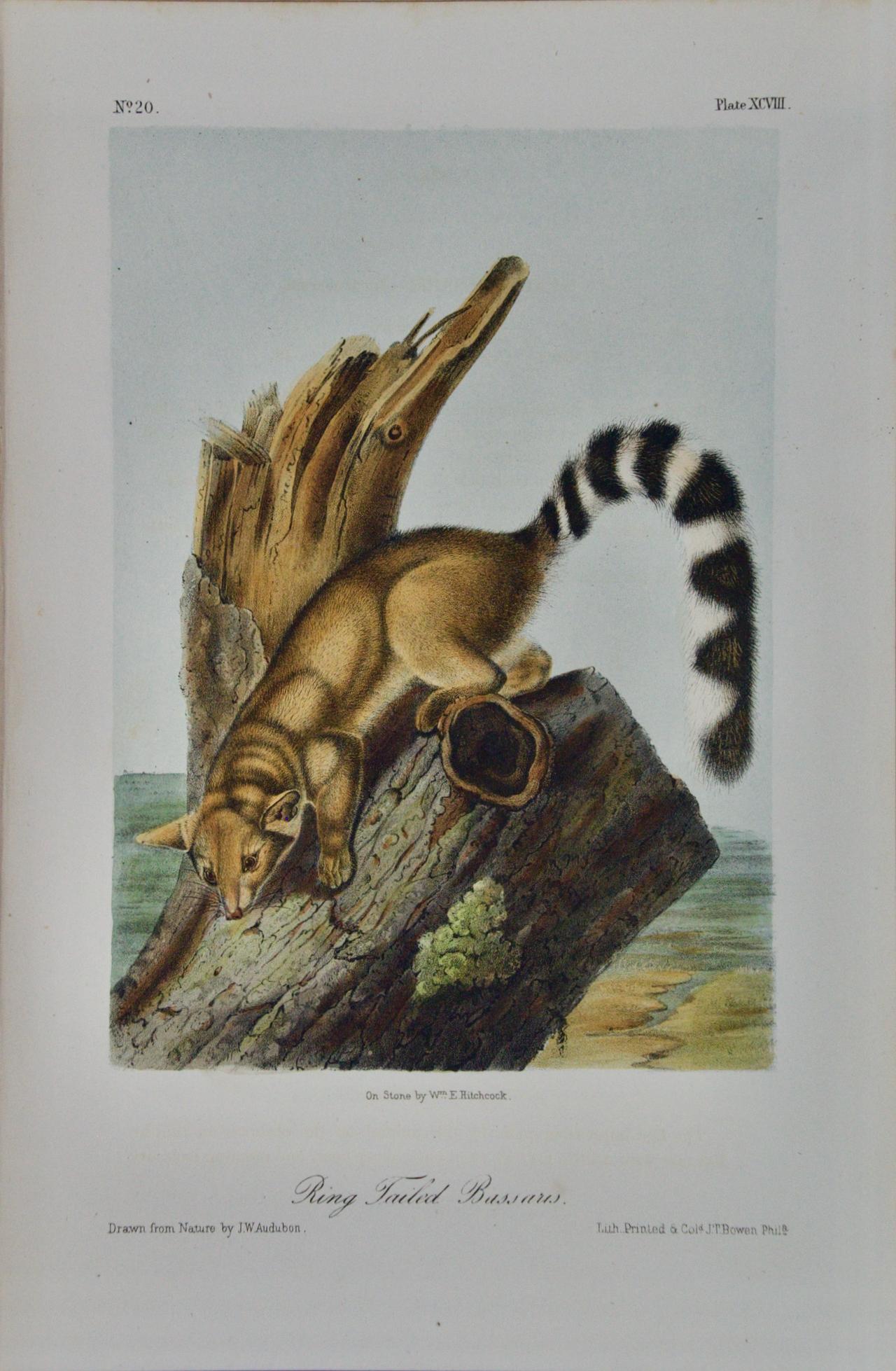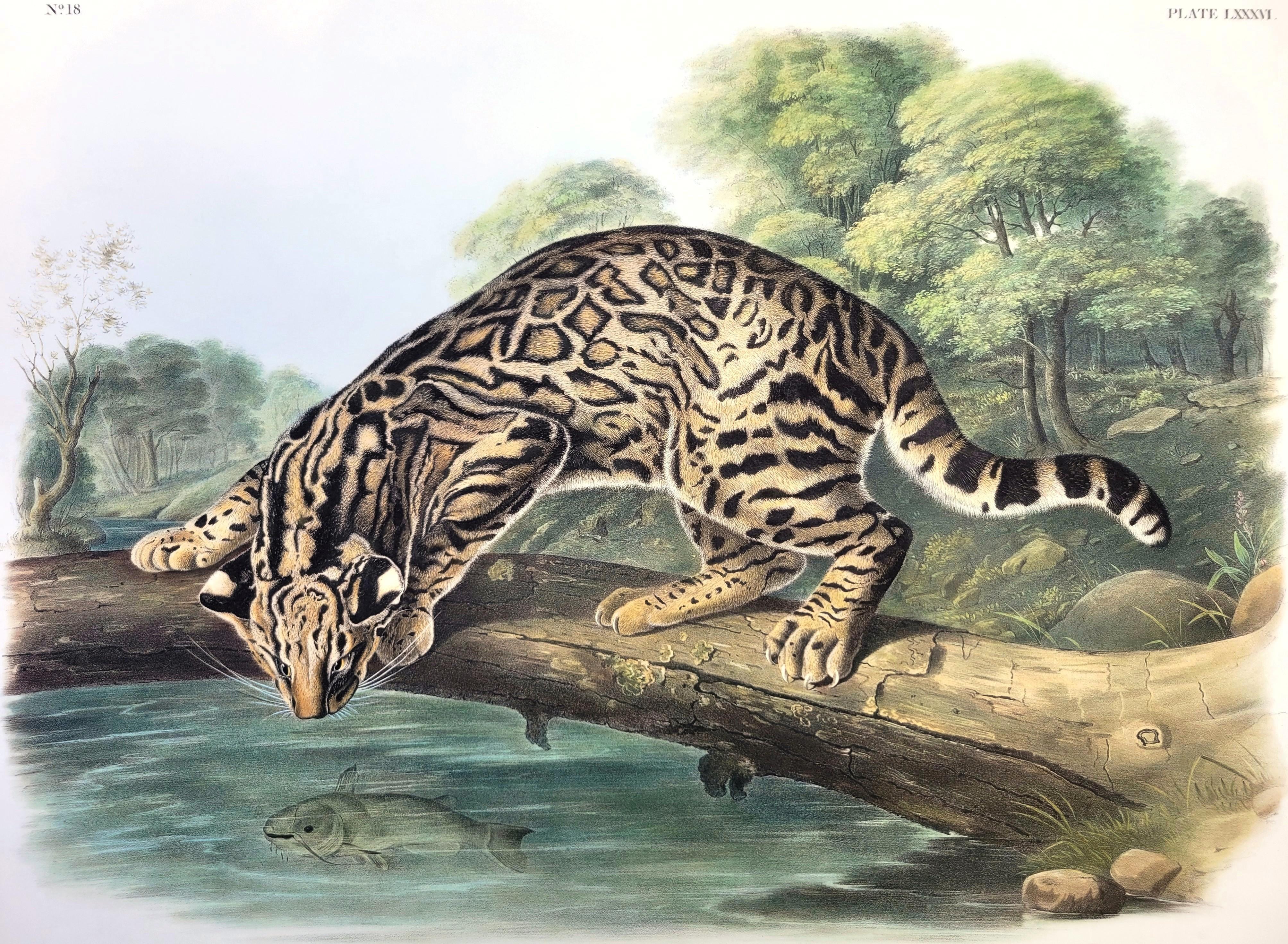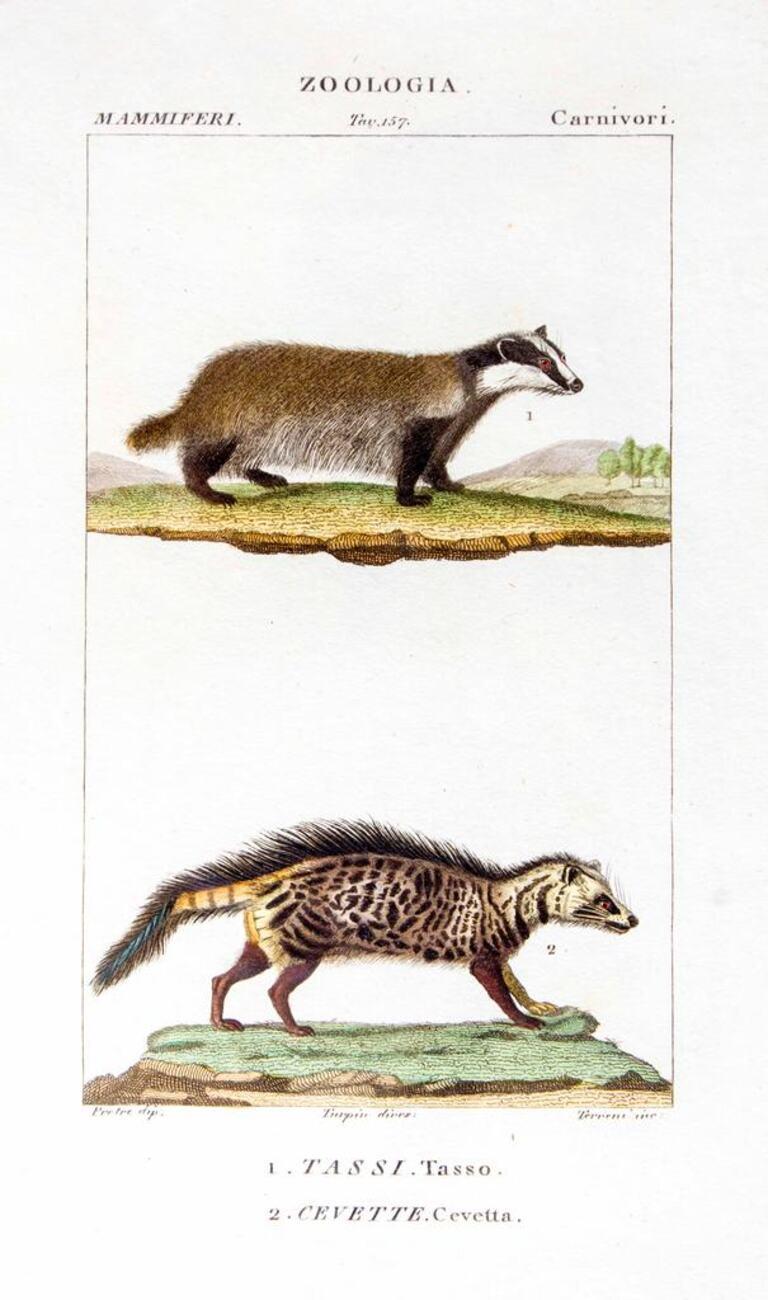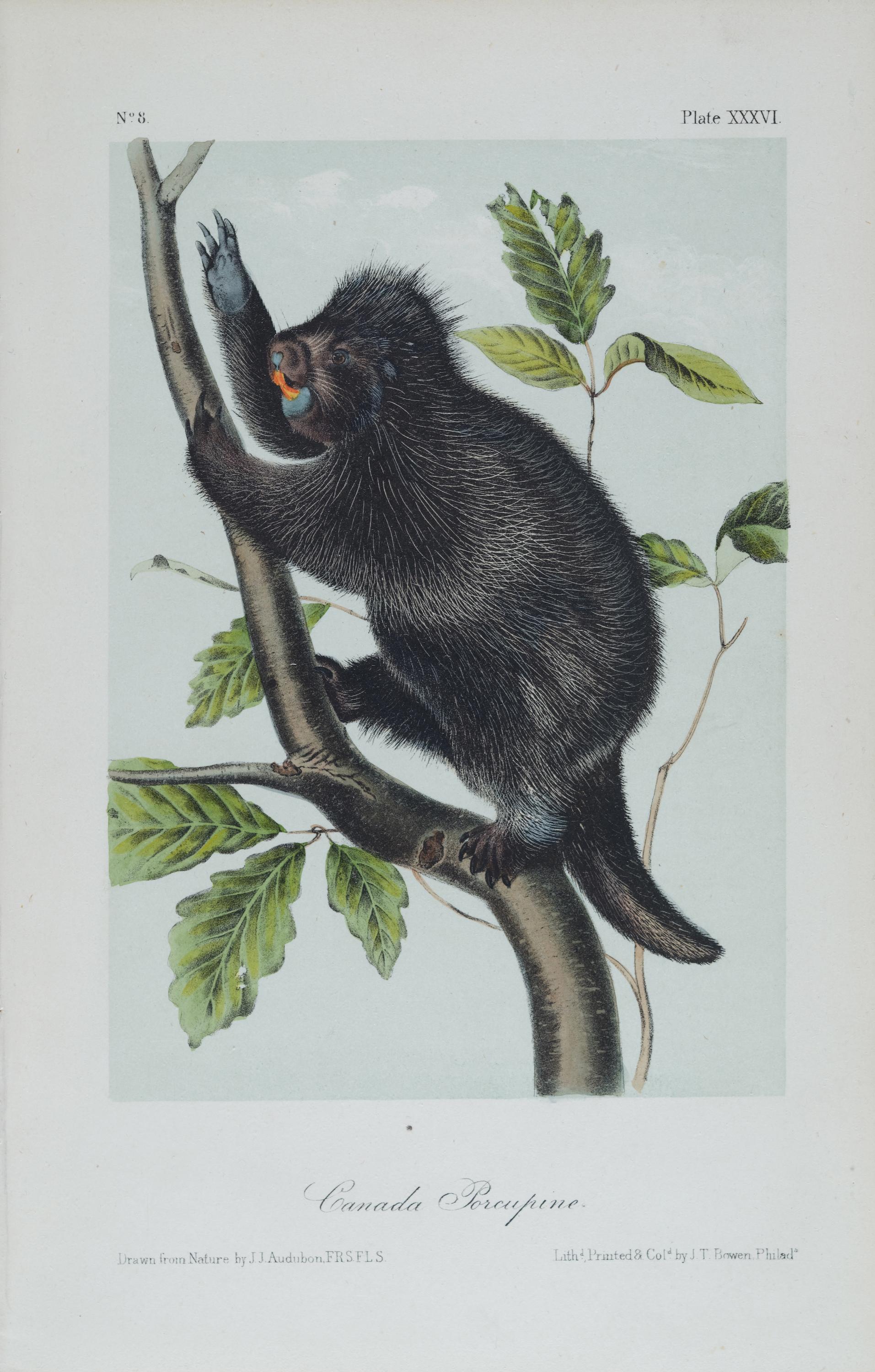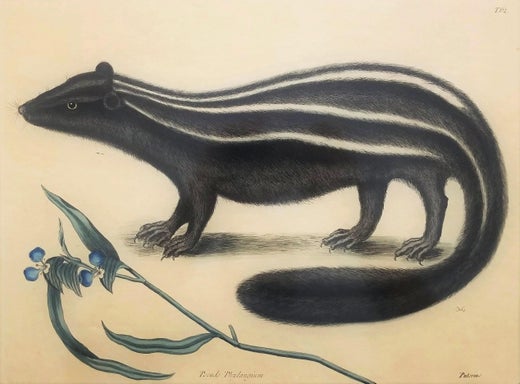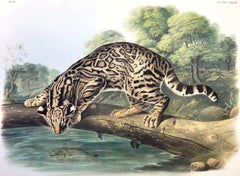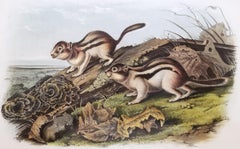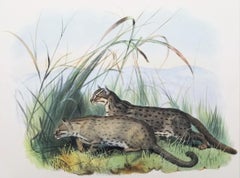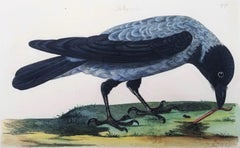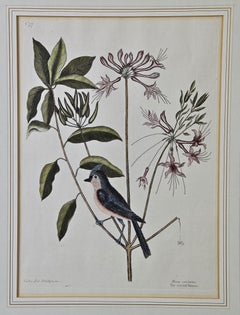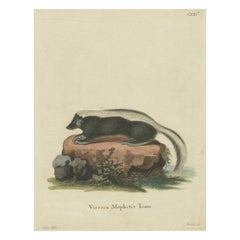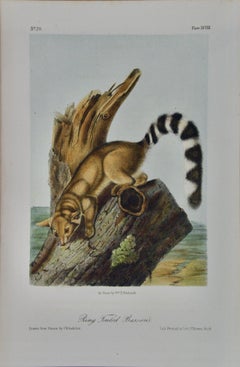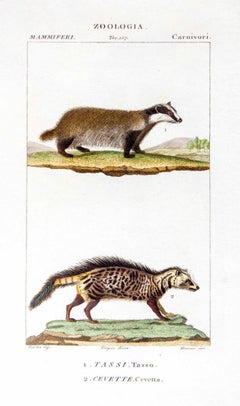Items Similar to Putorius & Pseudo Phalangium (The Pole-Cat) (Skunk) /// Mark Catesby Animal Art
Want more images or videos?
Request additional images or videos from the seller
1 of 24
Mark CatesbyPutorius & Pseudo Phalangium (The Pole-Cat) (Skunk) /// Mark Catesby Animal Art1771-1810
1771-1810
$600
$90033% Off
£466.35
£699.5233% Off
€528.03
€792.0433% Off
CA$857.29
CA$1,285.9333% Off
A$933.38
A$1,400.0733% Off
CHF 488.71
CHF 733.0633% Off
MX$11,203.68
MX$16,805.5233% Off
NOK 6,167.77
NOK 9,251.6533% Off
SEK 5,783.33
SEK 8,674.9933% Off
DKK 3,943.14
DKK 5,914.7133% Off
About the Item
Artist: Mark Catesby (English, 1638-1749)
Title: "Putorius & Pseudo Phalangium (The Pole-Cat) (Skunk)" (Plate/Tab 62)
Portfolio: Natural History of Carolina, Florida & the Bahama Islands
*Monogram signed by Catesby in the plate (printed signature) lower right
Year: 1771-1810 (third edition)
Medium: Original Hand-Colored Etching on cream J. Ruse handmade paper
Limited edition: Unknown
Printer: Unknown
Publisher: Benjamin White, London, UK
Framing: Recently framed in a black and gold moulding with 100% cotton linen fabric matting
Framed size: 21.63" x 25.19"
Sheet size: 13.75" x 21.13"
Platemark size: 10.25" x 13.75"
Condition: UV staining to sheet and mat stain in margins. Some soft handling creases. In otherwise good condition
Very rare
Notes:
Provenance: private collection - Miami, FL. Comes from Catesby's famous two volume portfolio "Natural History of Carolina, Florida & the Bahama Islands" (1771-1810) (third edition), which consists of 220 hand-colored etchings. "J. Ruse 1800" watermark lower right.
Mark Catesby's The Natural History of Carolina, Florida and the Bahama Islands is generally credited as the first published work to provide illustrations and descriptions of North American flora and fauna. From 1722-1726 Catesby, an English naturalist, ranged over South Carolina, Georgia and the Bahamas sketching and collecting specimens of native plants and animals.
Skunks are North and South American mammals in the family Mephitidae. While related to polecats and other members of the weasel family, skunks have as their closest Old World relatives the stink badgers. The animals are known for their ability to spray a liquid with a strong, unpleasant scent.
Biography:
Mark Catesby (24 March 1683 – 23 December 1749) was an English naturalist. Between 1729 and 1747 Catesby published his Natural History of Carolina, Florida and the Bahama Islands, the first published account of the flora and fauna of North America. It included 220 plates of birds, reptiles, amphibians, fish, insects, mammals and plants. Mark Catesby's The Natural History of Carolina, Florida and the Bahama Islands is generally credited as the first published work to provide illustrations and descriptions of North American flora and fauna. From 1722-1726 Catesby, an English naturalist, ranged over South Carolina, Georgia and the Bahamas sketching and collecting specimens of native plants and animals. Little is known of Catesby's early life. He was born in eastern England in 1683. Although Catesby does not appear to have attended university or studied for the Bar, he was sufficiently educated to write clear English and Latin. His interest in and knowledge of plants may have derived from his uncle, who maintained a botanical garden. Catesby also appears to have benefited from an acquaintance with John Ray, a leading English naturalist of the 17th century and the co-author of an early classic study of birds. It is unclear when or how Catesby developed his skills as an artist.
Catesby's first visit to North America occurred in 1712 when he traveled to Williamsburg, Virginia, to live with his sister and her husband, who had settled there. During his seven-year stay, he explored the length of the James River sketching plants and collecting botanical samples. Upon Catesby's return to England in 1719, his work in Virginia drew the attention of several influential members of the Royal Society. And with their financial backing, Catesby returned to North America three years later, arriving in Charleston in May 1722. During his four-year stay, he traveled throughout South Carolina, coastal Georgia and to the Bahamas. The sketches and specimens Catesby gathered during his second North American trip formed the basis for The Natural History of Carolina, Florida and the Bahama Islands. Although most often found as a two-volume set, Catesby's Natural History was published in 11 discrete sections from 1734-1747 and sold by subscription. Although Catesby died in 1749, his work was republished in 1754 and again in 1771. Catesby's work predated the classification system developed by Swedish botanist Carl Linneaus. However, the 1771 edition, featured here, includes a catalog of the Linnean names for the plants and animals Catesby featured in Natural History.
- Creator:Mark Catesby (1682 - 1749, English)
- Creation Year:1771-1810
- Dimensions:Height: 21.63 in (54.95 cm)Width: 25.19 in (63.99 cm)
- Medium:
- Movement & Style:
- Period:1770-1779
- Condition:
- Gallery Location:Saint Augustine, FL
- Reference Number:1stDibs: LU12128144042
Mark Catesby
Mark Catesby (24 March 1683 – 23 December 1749) was an English naturalist. Between 1729 and 1747 Catesby published his Natural History of Carolina, Florida and the Bahama Islands, the first published account of the flora and fauna of North America. It included 220 plates of birds, reptiles, amphibians, fish, insects, mammals and plants. Mark Catesby's The Natural History of Carolina, Florida and the Bahama Islands is generally credited as the first published work to provide illustrations and descriptions of North American flora and fauna. From 1722-1726 Catesby, an English naturalist, ranged over South Carolina, Georgia and the Bahamas sketching and collecting specimens of native plants and animals. Little is known of Catesby's early life. He was born in eastern England in 1683. Although Catesby does not appear to have attended university or studied for the Bar, he was sufficiently educated to write clear English and Latin. His interest in and knowledge of plants may have derived from his uncle, who maintained a botanical garden. Catesby also appears to have benefited from an acquaintance with John Ray, a leading English naturalist of the 17th century and the co-author of an early classic study of birds. It is unclear when or how Catesby developed his skills as an artist. Catesby's first visit to North America occurred in 1712 when he traveled to Williamsburg, Virginia, to live with his sister and her husband, who had settled there. During his seven-year stay, he explored the length of the James River sketching plants and collecting botanical samples. Upon Catesby's return to England in 1719, his work in Virginia drew the attention of several influential members of the Royal Society. And with their financial backing, Catesby returned to North America three years later, arriving in Charleston in May 1722. During his four-year stay, he traveled throughout South Carolina, coastal Georgia and to the Bahamas. The sketches and specimens Catesby gathered during his second North American trip formed the basis for The Natural History of Carolina, Florida and the Bahama Islands. Although most often found as a two-volume set, Catesby's Natural History was published in 11 discrete sections from 1734-1747 and sold by subscription. Although Catesby died in 1749, his work was republished in 1754 and again in 1771. Catesby's work predated the classification system developed by Swedish botanist Carl Linneaus. However, the 1771 edition, featured here, includes a catalog of the Linnean names for the plants and animals Catesby featured in Natural History.
About the Seller
5.0
Platinum Seller
Premium sellers with a 4.7+ rating and 24-hour response times
Established in 1978
1stDibs seller since 2015
1,358 sales on 1stDibs
Typical response time: <1 hour
- ShippingRetrieving quote...Shipping from: Saint Augustine, FL
- Return Policy
More From This Seller
View AllOcelot, or Leopard-Cat /// John James Audubon Quadruped Big Wild Cat Animal Art
By John James Audubon
Located in Saint Augustine, FL
Artist: John James Audubon (American, 1785-1851)
Title: "Ocelot, or Leopard-Cat" (Plate 86, No. 18)
Portfolio: The Viviparous Quadrupeds of North America, Imperial Bowen Edition
Year...
Category
1840s Victorian Animal Prints
Materials
Watercolor, Lithograph
Say's Marmot Squirrel /// John James Audubon Quadruped Natural History Animal
By John James Audubon
Located in Saint Augustine, FL
Artist: John James Audubon (American, 1785-1851)
Title: "Say's Marmot Squirrel" (Plate 114, No. 23)
Portfolio: The Viviparous Quadrupeds of North America, Royal Octavo Edition
Year: 1849-1870
Medium: Original Hand-Colored Lithograph on wove paper
Limited edition: approx. 8,000
Printer: John T. Bowen, Philadelphia, PA
Publisher: John Woodhouse Audubon...
Category
1850s Victorian Animal Prints
Materials
Watercolor, Lithograph
Felis Rubiginosa (Rusty-Spotted Cat) /// Daniel Giraud Elliot Cat Tiger Lion Art
By Daniel Giraud Elliot
Located in Saint Augustine, FL
Artist: Daniel Giraud Elliot (American, 1835-1915)
Title: "Felis Rubiginosa (Rusty-Spotted Cat)" (Plate: XXIX - 29)
Portfolio: A Monograph of the Felidae or...
Category
1870s Victorian Animal Prints
Materials
Watercolor, Lithograph
The Royston Crow (Hooded Crow) /// Thomas Pennant Ornithology Bird Animal Art
By Thomas Pennant
Located in Saint Augustine, FL
Artist: Thomas Pennant (Welsh, 1726-1798)
Title: "The Royston Crow (Hooded Crow)" (Plate D1)
Portfolio: The British Zoology, Class II: Birds
Year: 1761-1766 (First edition)
Medium: O...
Category
1760s Old Masters Animal Prints
Materials
Watercolor, Engraving, Laid Paper
American Anhinga - Snake Bird /// John James Audubon Ornithology Natural History
By John James Audubon
Located in Saint Augustine, FL
Artist: John James Audubon (American, 1785-1851)
Title: "American Anhinga - Snake Bird" (Plate 420, No. 84)
Portfolio: The Birds of America, First Royal Octavo Edition
Year: 1840-1844
Medium: Original Hand-Colored Lithograph on wove paper
Limited edition: approx. 1,200
Printer: John T. Bowen, Philadelphia, PA
Publisher: John James Audubon and J.B. Chevalier, New York, NY and Philadelphia, PA
Sheet size: 10" x 6.69"
Image size: 6.63" x 4.63"
Condition: Minor toning to sheet and some faint discoloration in margins. Old glue staining along right binding edge as normal. It is otherwise in very good condition with strong colors
Notes:
Provenance: private collection - Cleveland, OH. Lithography and hand-coloring by American artist John T. Bowen (1801-c.1856). Comes from Audubon's famous seven volume portfolio "The Birds of America", First Royal Octavo Edition (1840-1844), which consists of 500 hand-colored lithographs. The preceding 1836 Havell edition of this work has a different title: "Black-bellied Darter", (Plate: CCCXVI - 396, No. 64).
Based on a drawing inscribed "New Orleans 1822 - redrawn ... 1836". This conspicuous bird had various names including "water turkey" and "Bec à Lancette".
The Anhinga, sometimes called snakebird, darter, American darter, or water turkey, is a water bird of the warmer parts of the Americas. The word anhinga comes from a'ñinga in the Brazilian Tupi language and means "devil bird" or "snake bird".
To make 'The Birds of America' more affordable and widely available, in 1839 John James Audubon began the first octavo edition, a smaller version of the folio which was printed and hand-colored by J. T. Bowen in Philadelphia. Employing a new invention, the camera lucida, the images were reduced in size, rendered in intermediate drawings by John James Audubon and his son John Woodhouse, and then drawn onto lithographic stones. These miniatures exhibit a remarkable amount of attention to quality and detail, as well as a meticulous fidelity to the larger works. Some compositional changes were made in order to accommodate the smaller format. Like the Havell edition, John James Audubon’s first...
Category
1840s Victorian Animal Prints
Materials
Watercolor, Lithograph
Canard de Miclon (Old Squaw) /// Ornithology Martinet Bird Animal Art Duck
By François Nicolas Martinet
Located in Saint Augustine, FL
Artist: François-Nicolas Martinet (French, 1731-1800)
Title: "Canard de Miclon (Old Squaw)" (1008)
Portfolio: Histoire Naturelle Des Oiseaux
*Signed by Martinet in the plate (printed...
Category
1770s Old Masters Animal Prints
Materials
Watercolor, Laid Paper, Engraving, Intaglio
You May Also Like
18th Century Catesby Hand-colored Bird & Plant Engraving "The Crested Titmous"
By Mark Catesby
Located in Alamo, CA
A hand-colored copperplate engraving of a bird and plants by Mark Catesby (1683-1749) entitled "The Crested Titmous" from "The Natural History of Carolina, Georgia, Florida and the Bahama Islands", published in 1731. It depicts a small Crested Titmous bird, facing left, perched on the stem of a plant with clusters of mauve colored star-like flowers.
This original Catesby hand-colored engraving, on laid paper with a large central Fleur-de-Lys watermark, is presented in a cream color French mat. The mat measures 20" x 15.5" and the sheet measures 18.75" x 14.75".
Mark Catesby was born in England to a prosperous family, but he traveled to America, first to visit his sister and her husband in 1712. From 1712 to 1719 he explored America observing its birds and plants, taking notes, creating drawings and collecting specimens. He returned to England with this material and created more detailed drawings. His next visit to America 1722-1726 allowed for more detailed research. Upon his return to England he created his monumental and beautiful work "The Natural History of Carolina, Florida, and Bahama Islands", which was published in London in two folio volumes of 11 parts each consisting of 20 plates...
Category
Mid-18th Century Naturalistic Animal Prints
Materials
Engraving
$1,900 Sale Price
20% Off
Elegance in Black and White: the Striped Skunk Engraved, circa 1774
Located in Langweer, NL
Title: "Elegance in Black and White: Viverra Mephitis Linn."
Description: This hand-colored print, meticulously drawn by J. Hle and engraved by J. Beck, features 'Viverra Mephitis L...
Category
Antique 1770s German Prints
Materials
Paper
Ring-Tailed Bassaris: An Original Audubon Hand-colored Lithograph
By John James Audubon
Located in Alamo, CA
This is an original John James Audubon hand colored lithograph entitled "Ring-Tailed Bassaris", No. 20, Plate XCVIII, 98, from John James Audubon's Qu...
Category
Mid-19th Century Naturalistic Animal Prints
Materials
Lithograph
Tasso-Cevetta...-Etching by Jean Francois Turpin - 1831
By Pierre Jean François Turpin
Located in Roma, IT
This is one of the illustrations of " Dizionario di scienze naturali " (Natural sciences dictionary) edited by Battelli nel 1831. The work was made of 29 volumes, containing hundred...
Category
1830s Modern Animal Prints
Materials
Etching
$154 Sale Price
35% Off
Canada Porcupine: An Original 19th C. Hand-colored Lithograph by John J. Audubon
By John James Audubon
Located in Alamo, CA
This is an original 19th century John James Audubon hand-colored lithograph entitled "Canada Porcupine", No. 8, Plate XXXVI, from Audubon's "Viviparous Quadrupeds of North America", ...
Category
Mid-19th Century Naturalistic Animal Prints
Materials
Lithograph
19th-Century Lithograph of a Skunk and European Otter in Exquisite Detail
Located in Langweer, NL
19th-Century Lithograph of a Skunk and European Otter in Exquisite Detail
This beautifully executed 19th-century lithograph showcases two remarkable mammals: the skunk (Het stinkd...
Category
Antique 1830s Prints
Materials
Paper
More Ways To Browse
Mark English
Charleston Antique
Antique Badger
James Plant
Mark Catesby Antique Prints
Lloyd Kiva
Lobster Telephone
Norbertine Bresslern Roth
Owl Woodblock Print
Picasso Bird Lithograph
Picasso Bull Plate
Picasso Chien
Picasso Dove Lithograph
Picasso Lithograph Gold
Picasso Lithograph Owl
Picasso Print Dove
Poster Aesthetic Vintage Art
Prairie Dog
